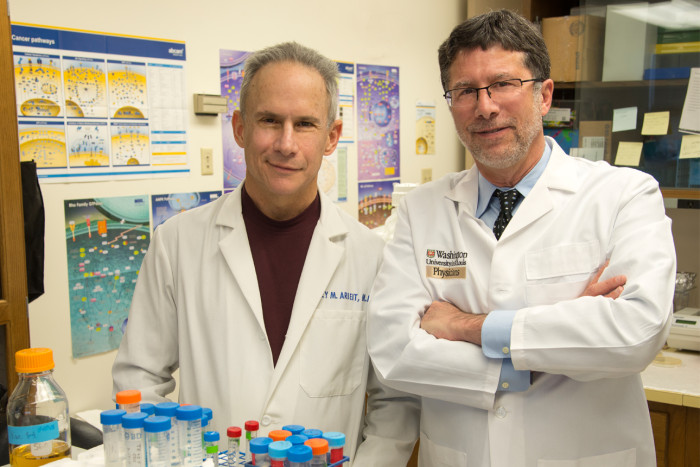Gene therapy delivery method successfully targets tumor blood vessels
Cancer researchers have developed a gene-delivery method that targets tumor blood vessels and could slow tumors’ growth or make them more susceptible to chemotherapy and radiation

Gene therapy method targets tumor blood vessels - Jeffrey M. Arbeit, MD, (left) and David T. Curiel, MD, PhD, and their colleagues designed a viral vector that homes in on the abnormal blood vessels of tumors, opening up new therapeutic possibilities for gene therapy against cancer.
Working in mice, researchers have engineered a deactivated virus that contains a gene that is turned on only in the inner lining of tumor blood vessels. In experiments, this modified virus caused the cells lining tumor blood vessels to glow green while healthy tissues in the lung, kidney, heart and other organs were untouched. Jeffrey Arbeit, MD, and David Curiel, MD, PhD, of the Alvin J. Siteman Cancer Center at Barnes-Jewish Hospital and Washington University School of Medicine performed the work.
Now that they have shown that this modified virus reaches the intended target, the researchers are working to use it and other such delivery viruses, known as vectors, to carry genes that will kill prostate or kidney cancers or enhance the potency of chemotherapeutic drugs.
“In the early 1980s, the so-called fathers of the gene therapy field advanced this idea of a targetable injectable—a vector you could inject in the blood and it would find the correct target cell, to which it could deliver genes efficiently and specifically,” says Curiel. “Our study was an initial step to show this was possible. To date, gene therapies in humans have largely involved taking cells out of the body, modifying them and putting them back in.”
Arbeit and Curiel are working with two models of metastatic cancer—prostate cancer and kidney cancer—to further test their vectors, in this case targeting both tumors that have spread to the bone and to solid organs. One goal is to attempt to disrupt the molecular pathways that maintain cancer stem cells, which reproduce themselves and generate new cancer cells. This work could make these cells more susceptible to chemotherapy.
“These cancer stem cells are not rapidly dividing cells, so they are resistant to chemotherapy. They also have an enhanced ability to pump out chemotherapy through pores in the cancer cell membrane,” Arbeit says. They would like to use gene therapy to prompt the growth of blood vessels that will then make molecules that block the formation of the cancer stem cells. Then conventional chemotherapy could have a better chance of potentially killing the cancer cells, Arbeit adds.
The researchers have identified two cancer stem cell pathways in prostate cancer and have produced cancer cells with reporter genes that turn the cells green when either pathway is turned on. This will enable them to see the activity of these cancer stem cells within cancer that has spread in a way few researchers have done. The technique is also practical for visualizing kidney cancer. A future step includes designing a viral vector delivering genes to block activation of the cancer stem cells.
In cancer treatment, there have been a host of therapies directed at tumor blood vessels, but these viral vectors offer the potential to deliver multiple inhibitors to block different pathways sustaining tumor growth. Arbeit and Curiel believe the vectors could also be extended to other cancers and even other diseases in which the blood vessels are abnormal.







